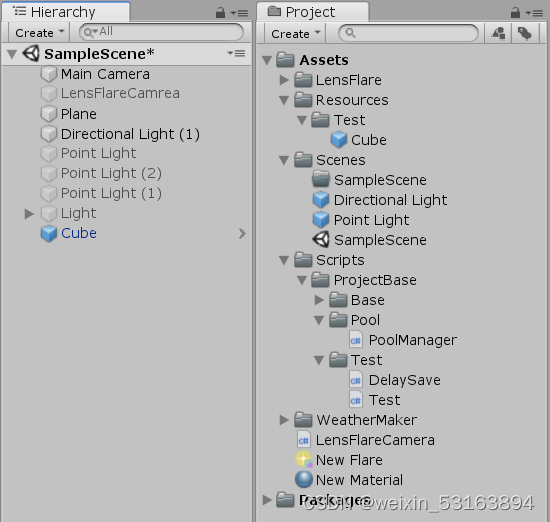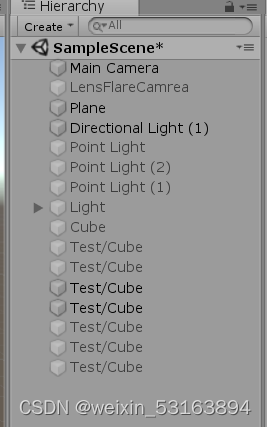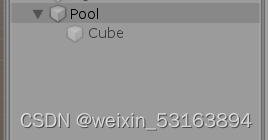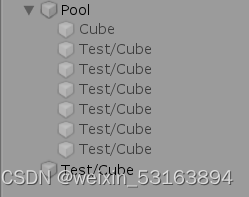Unity-缓存池
一、.基础缓存池实现

继承的Singleton脚本为
public class Singleton<T> where T : new()
{
private static T _instance;
public static T GetIstance()
{
if (_instance == null)
_instance = new T();
return _instance;
}
}1.PoolManager
using System.Collections;
using System.Collections.Generic;
using UnityEngine;
using UnityEngine.Events;
/// <summary>
/// 抽屉数据 池子中的一列容器
/// </summary>
public class PoolData
{
//抽屉中 对象挂载的父节点
public GameObject fatherObj;
//对象的容器
public List<GameObject> poolList;
/// <summary>
/// 对象池-根节点-父节点-对象
/// </summary>
/// <param name="obj">对象</param>
/// <param name="poolObj">根节点</param>
public PoolData(GameObject obj, GameObject poolObj)
{
//给我们的抽屉 创建一个父对象 并且把他作为我们pool(衣柜)对象的子物体
fatherObj = new GameObject(obj.name);
fatherObj.transform.parent = poolObj.transform;
poolList = new List<GameObject>() { };
PushObj(obj);
}
/// <summary>
/// 往抽屉里面 压都东西
/// </summary>
/// <param name="obj"></param>
public void PushObj(GameObject obj)
{
//失活 让其隐藏
obj.SetActive(false);
//存起来
poolList.Add(obj);
//设置父对象
obj.transform.parent = fatherObj.transform;
}
/// <summary>
/// 从抽屉里面 取东西
/// </summary>
/// <returns></returns>
public GameObject GetObj()
{
GameObject obj = null;
//取出第一个
obj = poolList[0];
poolList.RemoveAt(0);
//激活 让其显示
obj.SetActive(true);
//断开了父子关系
obj.transform.parent = null;
return obj;
}
}
/// <summary>
/// 缓存池模块
/// 1.Dictionary List
/// 2.GameObject 和 Resources 两个公共类中的 API
/// </summary>
public class PoolMgr : Singleton<PoolMgr>
{
//缓存池容器 (衣柜)
public Dictionary<string, PoolData> poolDic = new Dictionary<string, PoolData>();
//创建根节点
private GameObject poolObj;
/// <summary>
/// 从缓存池中往外拿东西
/// </summary>
/// <param name="name"></param>
/// <returns></returns>
public void GetObj(string name,UnityAction<GameObject> callBcak )
{
//1.衣柜中有抽屉,抽屉里有东西
if (poolDic.ContainsKey(name) && poolDic[name].poolList.Count > 0)
{
callBcak(poolDic[name].GetObj());
}
//2.抽屉中无东西
else
{
//缓存池中没有,从resources文件夹下拿Cube预制体
//obj = GameObject.Instantiate(Resources.Load<GameObject>(name));
//通过异步加载资源创建对象 给外部调用
ResMgr.GetInstance().LoadAsync<GameObject>(name, (o) =>
{
o.name = name;
callBcak(o);
});
//将对象名字修改为池名字
//obj.name = name;
}
}
/// <summary>
/// 存入缓存池
/// </summary>
public void PushObj(string name, GameObject obj)
{
//判断Pool是否为空
if (poolObj == null)
poolObj = new GameObject("Pool");
//1.有抽屉
if (poolDic.ContainsKey(name))
{
poolDic[name].PushObj(obj);
}
//2.没有抽屉
else
{
//创建抽屉
poolDic.Add(name, new PoolData(obj, poolObj));
}
}
/// <summary>
/// 清空缓存池的方法
/// 主要用在 场景切换时
/// </summary>
public void Clear()
{
poolDic.Clear();
poolObj = null;
}
}2.Test
挂载到摄像机上
using System.Collections;
using System.Collections.Generic;
using UnityEngine;
public class Test : MonoBehaviour
{
void Update()
{
if (Input.GetMouseButtonDown(0))
{
//路径名
PoolMgr.GetInstance().GetObj("Test/Cube", (o) => { });
}
}
}
3.DlaySave
挂载到预制体Cube上
using System.Collections;
using System.Collections.Generic;
using UnityEngine;
public class DelaySave : MonoBehaviour
{
//当对象激活时,进入生命周期函数
void OnEnable()
{
Invoke("Save", 1);
}
void Save()
{
PoolManager.GetIstance().SaveObj(this.gameObject.name, this.gameObject);
}
}

二、缓存池优化
在生成物体时设置为Pool的子物体


using System.Collections;
using System.Collections.Generic;
using UnityEngine;
/// <summary>
/// 抽屉数据 池子中的一列容器
/// </summary>
public class PoolData
{
//抽屉中 对象挂载的父节点
public GameObject fatherObj;
//对象的容器
public List<GameObject> poolList;
public PoolData(GameObject obj, GameObject poolObj)
{
//给我们的抽屉 创建一个父对象 并且把他作为我们pool(衣柜)对象的子物体
fatherObj = new GameObject(obj.name);
fatherObj.transform.parent = poolObj.transform;
poolList = new List<GameObject>() { };
PushObj(obj);
}
/// <summary>
/// 往抽屉里面 压都东西
/// </summary>
/// <param name="obj"></param>
public void PushObj(GameObject obj)
{
//失活 让其隐藏
obj.SetActive(false);
//存起来
poolList.Add(obj);
//设置父对象
obj.transform.parent = fatherObj.transform;
}
/// <summary>
/// 从抽屉里面 取东西
/// </summary>
/// <returns></returns>
public GameObject GetObj()
{
GameObject obj = null;
//取出第一个
obj = poolList[0];
poolList.RemoveAt(0);
//激活 让其显示
obj.SetActive(true);
//断开了父子关系
obj.transform.parent = null;
return obj;
}
}
/// <summary>
/// 缓存池模块
/// 1.Dictionary List
/// 2.GameObject 和 Resources 两个公共类中的 API
/// </summary>
public class PoolMgr : Singleton<PoolMgr>
{
//缓存池容器 (衣柜)
public Dictionary<string, PoolData> poolDic = new Dictionary<string, PoolData>();
private GameObject poolObj;
/// <summary>
/// 往外拿东西
/// </summary>
/// <param name="name"></param>
/// <returns></returns>
public GameObject GetObj(string name)
{
GameObject obj = null;
//有抽屉 并且抽屉里有东西
if (poolDic.ContainsKey(name) && poolDic[name].poolList.Count > 0)
{
obj=poolDic[name].GetObj();
}
else
{
obj = GameObject.Instantiate(Resources.Load<GameObject>(name));
//把对象名字改的和池子名字一样
obj.name = name;
}
return obj;
}
/// <summary>
/// 换暂时不用的东西给我
/// </summary>
public void PushObj(string name, GameObject obj)
{
if (poolObj == null)
poolObj = new GameObject("Pool");
//里面有抽屉
if (poolDic.ContainsKey(name))
{
poolDic[name].PushObj(obj);
}
//里面没有抽屉
else
{
poolDic.Add(name, new PoolData(obj, poolObj));
}
}
/// <summary>
/// 清空缓存池的方法
/// 主要用在 场景切换时
/// </summary>
public void Clear()
{
poolDic.Clear();
poolObj = null;
}
}